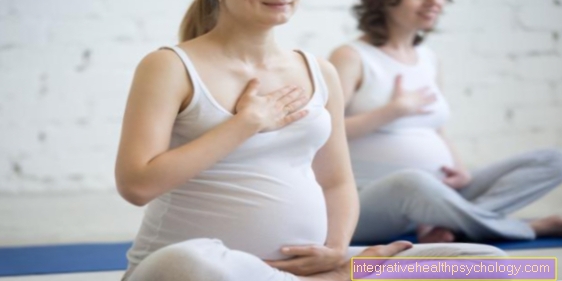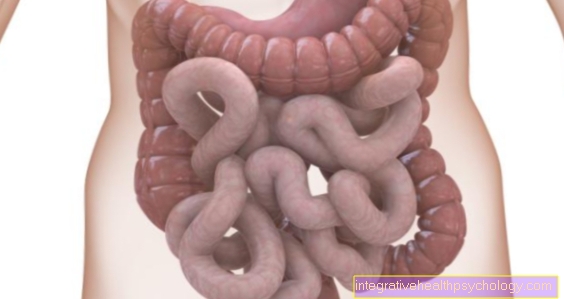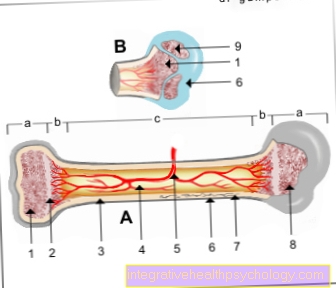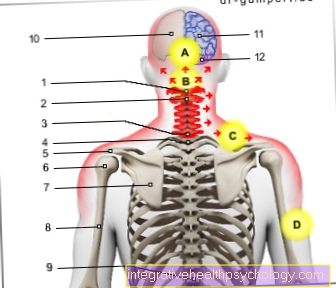Breathing at birth
What is correct breathing at birth?
Birth presents women with a special and unique challenge. Prenatal courses, which are predominantly run by midwives, are designed to help women prepare for the demands of childbirth.
A central topic of such courses is the correct breathing technique or breathing during childbirth. These are breathing exercises and breathing techniques that are designed to help relieve labor pain both before and during delivery. Above all, they serve to relax the woman and to facilitate the birth process. The breathing exercises are based on both physical and psychological effects. Sufficient mental but also physical relaxation should ensure a good birth process.

What role does breathing play in childbirth?
Natural birth takes place in various defined phases that are passed through one after the other.
- The opening phase: This is characterized by the beginning of labor and which is used to open the cervix. The birth is practically initiated.
- The expulsion phase: This is the actual birth.
- The postpartum period: This follows after the baby is born. In this phase the placenta is born and the afterbirth contractions dominate.
Breathing plays a not insignificant role in the mother's wellbeing in all phases. Correct breathing can make childbirth more comfortable for the mother and, above all, help her to press properly during the expulsion phase. However, there is no risk of harming the child through "wrong" breathing. Breathing courses preparing for birth should only be attended if the mother-to-be feels comfortable and feels personally enriched. Breathing works intuitively even without special techniques, so that no expectant mother has to be afraid of doing something wrong.
You might also be interested in the topic: Pain During Childbirth and Ways to Get Pain Relief
How should one breathe during the birth stages?
Adapted breathing techniques can provide good support for the mother in the different phases of birth.
In antenatal courses, the special requirements of each phase of birth are addressed. In the following section, different breathing techniques for the three phases of labor opening, expulsion and postpartum are explained in more detail.
Breathing during the opening phase
The opening phase begins with the opening labor that dilates the womb and usually lasts between three and twelve hours.
The rhythmic contractions come at intervals of about ten minutes, shortly before the birth about every two to three minutes. For many women, even, deep breaths, known as “breathing into the stomach”, have a relaxing effect. Even and calm breaths are important. It is recommended to inhale through your nose and exhale through your open mouth. Contrary to previous recommendations, nowadays so-called "panting" (see section "What is meant by panting?") Is discouraged in most antenatal courses.
Read more on the topic: Breathing exercises
Breathing in the expulsion phase
In the expulsion phase, the so-called expulsion contractions dominate, which serve the birth of the child with high intensity. When the cervix is completely open, the expulsion contractions reach peak pressures of up to 200mmHg, which is why they are also known as pressure contractions.
Breathing as evenly and consistently as possible is also important here. While many women tend to hold their breath while pressing, it is better to breathe calmly. At the end of a pressing phase, you should breathe in and out deeply. Holding your breath for long periods of time can lead to hyperventilation due to the rapid sigh of relief. Therefore, calm breathing is even more important. If the pain is severe, it can also help to make deep tones such as "A" or "Yes" when you exhale.
You might also be interested in: The different types of labor
Breathing during the postpartum period
In the postpartum period, the new mother should remember to relax and rest.
A calm and even breathing, as it is also recommended in the opening period, is also advisable here. Deep breaths and extended exhalation through the open mouth help very well.
Read more on the topic:
- Birth pain
- Labor pains
Where and how can I practice this in advance?
In order to prepare for the birth, there are various birth preparation courses which, among other things, specifically address the topic of "breathing during birth".
If you are interested in such courses, it is highly advisable to contact your own health insurance company for purely informative purposes. Often there are partnerships with local midwives who offer courses. Direct contact can thus be established relatively easily. Otherwise, you can also ask in maternity clinics or with friends.
Such courses can be attended alone or with a partner. There are no special requirements or preparations necessary to participate. Of course, you can also prepare for breathing during childbirth in your own home. A midwife can also make home visits in advance of the birth. Simple breathing exercises can also be done alone without assistance. A pregnancy guide or a book can be used as instructions.
You can find out more about the topic here: Birth preparation course
Can you breathe incorrectly during childbirth?
Many expectant mothers are afraid of doing something wrong during childbirth. In this context, the pain of expulsion and the high-frequency labor are of particular concern. Many mothers want to be optimally prepared and therefore deal in advance with breathing during the birth. However, it must be emphasized that there is no such thing as wrong or right breathing in this sense. Rather, regular and intuitive breathing is important. Special techniques do not need to be used.
However, some things should be avoided.This includes, above all, holding your breath for a long time during the expulsion of the child. This reflexively leads to gasping for air at the end of the pressing phase and can encourage hyperventilating. Rather, one should make sure to always breathe through the contractions, even if it is very difficult to do so while pressing. However, incorrect breathing per se is not really possible. As a rule, you can intuitively find a good breathing rhythm that should not be disturbed from outside. During childbirth, a woman should breathe as she feels comfortable.
You might also be interested in the topic: Pregnancy gymnastics
What is panting?
The term "panting" is often misunderstood in connection with breathing during childbirth.
Most of the time, "panting" means rapid, panting breathing that leads to hyperventilation. However, this is not conducive to childbirth and leads to symptoms such as dizziness, blurred vision, panic and tingling sensations on the fingers in the mother. This type of "panting" should therefore be avoided, even if it is recommended by various sources, for example from friends.
In some cases, however, midwives also refer to “panting” when they mean deep, regular breathing, with inhaling through the nose and exhaling through the wide-open mouth. This type of breathing is conducive to the birth period and, unlike fast and shallow breathing, does not lead to hyperventilation. However, the term "panting" should not be used as it often leads to misunderstandings.
You may also be interested in this topic: Breathe in contractions
What can I do not to hyperventilate during childbirth?
Especially during the expulsion phase of labor, some women tend to hyperventilate. This often happens quite unconsciously.
Often the mother-to-be holds her breath during the pressing phase and then quickly gasps for air at the end of the pressing phase. This can quickly lead to a kind of panting, snapping breath that leads to hyperventilation. However, one can consciously counteract this by focusing on calm and constant breathing and carrying this out with the support of the midwife, doctor or accompanying relatives. Even during the pressing phases you should try to breathe through the contraction. This can be extremely difficult, but it can be done with a little concentration and makes the birth a lot easier.
You may also be interested in this topic: Maternity allowance





























